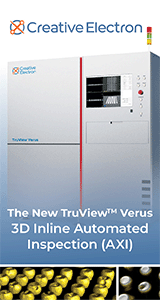| Sponsor |

|
AVOID THE VOID® with Proven Solder Paste
Looking to achieve void reduction and enhanced SIR performance? Indium8.9HF is your proven, no-clean, Pb-free, halogen-free, solder paste solution.
Indium Corporation
|
|
| Ask the Experts |
|
|
October 2, 2006 - Updated
July 4, 2007 - Originally Posted
Proper hand soldering settings
What are the considerations of lead free hand soldering of plated through holes (PTH) boards & multi layer board? Please advise standard temperature setting of soldering station.
Veerendra Kumar Singh
|
| Expert Panel Responses |
The important factors for any hand soldering application are temperature, repeatability and thermal response.
You need to solder at the lowest possible temperature that achieves high quality solder joints while maintaining your desired thruput on your production line. This is usually in the 700 - 750F range. But you also need to consider the repeatability of the temperature at the end of your soldering tip, it needs to maintain that temperature + / - 10F and idealy your station should not require calibration.
Finally you should seek a variable power soldering system NOT a variable temperature system. This will ensure that your operators cannot vary the operating temperature of the system and because it is variable power the tip temperature will remain fixed regardless of the load from the PCB. So they can go from joint to joint faster overcommin the thruput reduction associated with lead free solders.
Edward Zamborsky
Regional Sales Manager
OK International Inc.
Ed Zamborsky is a Regional Sales & Technical Support Manager for Thermaltronics, located in New York. His position requires frequent customer visits throughout North America and the Caribbean and his position encompasses not only sales but the role of trainer and master applications engineer for all of Thermaltronics products. His expertise includes such specialties as hand soldering, convection and conduction reflow techniques, array rework, fluid dispensing equipment, and fume extraction. Ed has authored many articles and has presented many papers on topics such as; Low Volume SMT Assembly, Solder Fume Extraction, SMT Rework, BGA Rework, Lead-Free Hand Soldering, High Thermal Demand Hand Soldering, Lead Free Visual Inspection and Lead Free Array Rework.
|
|
Submit A Comment
|
Comments are reviewed prior to posting. You must include your full name to have your comments posted. We will not post your email address.
|
Free Newsletter Subscription
Circuitnet is built for professionals who bear the responsibility of looking ahead, imagining the future, and preparing for it.
Insert Your Email Address
|
| Sponsor |

|
Silver Filled, Heat Curing Epoxy
Master Bond EP4S-80 is a one part, electrically conductive, silver filled adhesive for bonding, sealing and coating with a low curing temperature of 80°C.
Master Bond
|
|
|





